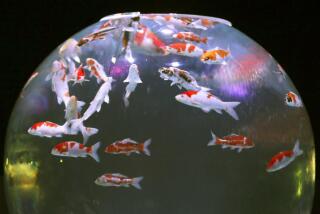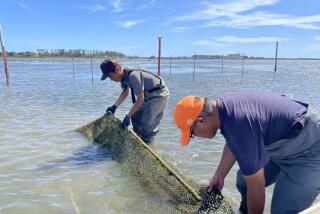Japan Pearl Center Loses Its Luster and Dominance to Pollution, Over-Cultivation
- Share via
KASHIKOJIMA, Japan — Jino Iwaki spreads out strands of lustrous pearls in his wharfside shop on tranquil Ago Bay, where the technique of pearl cultivation was first perfected in Japan at the turn of the century.
“The quality of pearls is declining and the larger variety is getting harder to come by,” sighed Iwaki, whose family business dates back to the 1920s, when pearl cultivation began to flourish on the Pacific seaboard of Mie prefecture.
Water pollution and over-cultivation have taken their toll on Mie’s once-lucrative pearl industry. Up until about 1980, the Mie region produced over 70% of Japan’s saltwater pearls. Now it accounts for just 25%.
“The Mikimoto family has even given up cultivating pearls here, leasing its water rights to others,” said Iwaki.
Kokichi Mikimoto perfected the technique of artificial pearl cultivation at Ago Bay in the late 19th Century, after its discovery in China. A major jewelry company still bears his name.
About 300 families control the water rights at Ago Bay, whose deep and protected coves once sheltered Japanese pirates in the feudal ages.
Wooden rafts, floats for the 10,000 oyster lines that an average cultivator handles, crisscross the harbor.
In the first year, pollution kills off about 50% of Mie’s mother shells. By the third year, when growers can expect to gather the most sought-after large pearls, only 30% of the shells are still alive.
Mie’s production of large-sized pearls, a third of an inch or bigger, has fallen dramatically--from 9.5 tons in 1960 to about 2 tons today.
Meanwhile, wholesale prices for large pearls shot up 30% last year.
As Mie’s pearl industry declined over the last decade, two other regions--nearby Shikoku Island and southern Japan’s Nagasaki--have emerged to dominate production.
The Mie region produced just 19.25 tons, or 25% of the country’s 77-ton output of pearls in fiscal 1989.
The Shikoku and Nagasaki pearl regions are not immune from pollution by industrial and household waste and herbicide runoff from nearby golf courses.
“Japan’s pearl production is exceeding demand but there’s a problem of quality because of pollution and cultivators overloading their lines with oysters,” said an official at the National Research Institute of Aquaculture.
In order to boost production, cultivators are placing more oysters in water beds in all three regions. But the practice has led to an increase in plankton, which prevents formation of quality pearls with good luster.
“They overload their oyster lines in secret, working at night,” said a Mie cooperative official.
“In addition, we don’t have a sewage system in the region and there’s a lot of runoff from homes and hotels that line the coast,” he said.
Ago Bay’s Iwaki laments the decline of Mie’s prominence.
Regardless of the industry’s woes, Japanese consumers have a penchant for home-grown pearls.
Princess Kiko, who charmed the nation’s teen-age girls with her storybook wedding last June to the emperor’s son, is said to have spurred a pearl boom by wearing them in public. But statistics show that pearl sales were growing well before Kiko’s marriage to Prince Akishino.
Pearls accounted for 10% of Japan’s $15 billion in jewelry sales in 1989 in a market second only to the United States.
Tasaki Pearl Co., a leading pearl exporter, said wholesale sales grew about 60% in the last six months of fiscal 1989. Mikimoto’s Tokyo office reported annual double-digit growth figures for pearl sales for the last two years.
The domestic industry, which purchases half of Japan’s total pearl harvest each year, is eyeing China as an alternative source for high-quality pearls.
About half of Japan’s freshwater pearls, oblong in shape, are already imported from China.
More to Read
Sign up for Essential California
The most important California stories and recommendations in your inbox every morning.
You may occasionally receive promotional content from the Los Angeles Times.













